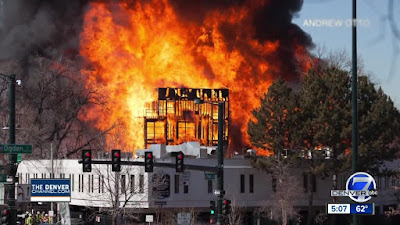Photo: photosourcewest
On Nov. 15, 1987, Continental Airlines Flight 1713 crashed as it departed Denver's Stapleton International Airport in a snowstorm, killing 28 people and injuring 54 others.
It was Stapleton's deadliest accident.
Airport fire stations No. 1 and No. 2 were alerted to the crash by the control tower at 2:16 p.m. and responded with five crash trucks and 12 firefighters, according to the National Transportation Safety Board report on the accident.
A full first alarm for city stations was transmitted at 2:21 p.m., followed by a second alarm at 2:33 p.m. and a third alarm at 3 p.m, the NTSB said, with Aurora, Sable Altura, Glendale and Thornton providing mutual aid.
``The plane skidded out of control for about a quarter of a mile before sliding off the runway northeast of the main terminal'' and ''flipped onto its back and broke into three pieces,'' The New York Times reported.
``The whole fuselage twisted like a chicken whose neck was wrung,'' said Richard Boulware, an airport official quoted by the Los Angeles Times.
Firefighters worked for 2 1/2 hours to free survivors from the wreckage of the DC-9 jetliner after extinguishing several fires.
"They were digging them out row by row," said Joe Cipri, a firefighter quoted by the Associated Press. "Some were screaming, but most people were real calm - just waiting their turns to get out." One victim yelled "Get me out of here" but was dead by the time firefighters reached him, Cipri said.
The NTSB said rescuers worked to reach 18-20 victims near the broken left wing and used wooden cribbing and a forklift to support the intact right wing, which as full of fuel. Firefighter Rory Moore said it was "a horrible feeling - a helpless feeling" trying to reach so many people.
Investigators concluded icing and crew error contributed to the crash of Flight 1713, which was bound for Boise, Idaho. The pilot and co-pilot were among the dead and it wasn't clear if the aircraft left the ground. "If it got off, it was not far enough for it to be detected by radar," said Fred Farrar, a spokesman for the Federal Aviation Administration.
Survivor Robert Linck told People Magazine:
``Everything was smooth until we lifted off, then the plane started shaking violently. There was an explosion, and a ball of fire shot up through the floor, sheer white heat, enveloping the two rows ahead of me. I said, ‘I think we’ve had it.’ I tried to stand up, get away from the flames. That’s how I got the [second-degree] burns on my hands. I heard three explosions, then the lights went out and people started screaming. First the right wing dropped, and then the left wing dropped. I think the pilot over-corrected to the left. The plane flipped.
``In that last blinding second before we hit, I only thought one thing: I couldn’t believe this was happening to me. We smacked the ground with an impact so severe—I’ve been hit hard playing football but never like that. In the minutes after, there was not a single sound. It was utterly silent and totally black. That, believe me, was frightening. I was lying flat on my chest and I couldn’t see a thing. I wondered if that fireball had set the plane on fire, if I’d be burned to death. Then somebody, a passenger or a ground crewman, came through and said not to panic, there was no fire.''
Another survivor recalled the impact.
``The metal was starting to tear apart. I thought about a crash in Reno where some kid survived because he was thrown from the plane still in his seat,'' said Douglas Self , quoted by the Los Angeles Times. ``The next thing I remember, I was in the field. I was in my chair. There were two chairs intact. I was sort of on my side, and the man in the other chair was over my shoulder.
``When I went to move him, I realized he was too light - that all of him wasn't there anymore. He was pretty torn up. Dead,'' Self said. ``Then I took off running. But the fog and the snow were so bad, I couldn't see the lights to the runway. Then I heard a sound and saw a blond girl about 13 or 14 years old. I just tried to keep her calm. She kept asking: 'Where are we?' ''
Other major incidents:
On Nov. 1, 1955, a bomb blast tore through United Airlines Flight 629, bound for Portland from Stapleton. The DC-6 aircraft crashed near Longmont, killing all 44 aboard.
On July 11, 1961, United Airlines Flight 85 veered off a runway on landing and burst into flames. Seventeen of the 122 aboard died. The driver of a vehicle struck by the DC-8 also died.
On Oct. 31, 1969, a hijacker commandeered TWA Flight 85 from Los Angeles to San Francisco and the aircraft landed in Denver where all the passengers and three flight attendants were released. The flight continued onto Rome by way of New York, Bangor and Shannon, Ireland.
On Aug. 7, 1975, windshear caused Continental Airlines Flight 426, a Boeing 727 bound
for Wichita, to crash after climbing to 100 feet. There were no deaths.
On Nov. 16, 1976, a Texas International DC-9 bound for Houston crashed on takeoff . Of the 81 passengers and 5
crew, 14 were injured. There were no fatalities.































